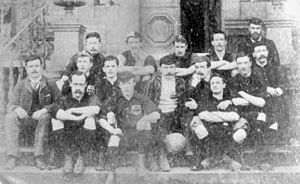Sheffield rules
The Sheffield Rules were football guidelines developed in the English city of Sheffield between 1857 and 1877 and according to which the game was played there. The rules were invented by Nathaniel Creswick and William Perst for use by the newly formed Sheffield Football Club . They were adopted as the official rules of the Sheffield Football Association , founded in 1867 . Over time, other clubs and associations in northern and central England also applied the rules, making them the most popular form of football between 1860 and 1870. It was not until six years after the Sheffield Rules were developed that the official rules of football were established . These were influenced by the Sheffield Rules, but due to constant arguments about them, the Sheffield Rules continued to be used. During this time, many elements of the Sheffield Rules found their way into the game of football. Regular games between London and Sheffield were played under both sets of rules, and it was finally agreed in 1877 that the Football Association would develop and administer a common set of rules .
The Sheffield Rules had a huge impact on the development of modern football. They introduced the concept of the free kick after foul , the corner kick and the throw-in . The task of the Fair Catch , in which the ball was initially allowed to be caught by hand, led to the development of the header. Only the goalkeeper, whose position was created by the Sheffield Rules, was allowed to play the ball by hand. The first championship games between clubs were played under the Sheffield rules.
background
The oldest verifiable football game in Sheffield took place in 1794 between Sheffield and Norton in Sheffield's Bents Green district. The game lasted three days, which was not unusual at the time. It was noted that there were no fatalities during the game, despite multiple injuries. By around 1850, different versions of football were played in public schools and clubs in England. Each school played by its own rules, although Cambridge University attempted to standardize them in 1848 . However, the rules were barely accessible outside of schools. At the time, football tended to be disorganized and was considered a random game known as mob football. Although there were games between smaller teams of equal strength, it remained a minority sport until the 1860s.
During the winter months of 1855, the Sheffield Cricket Club players organized informal football games to keep them fit until the new season started. Two of these players were Yorkshire-born Nathaniel Creswick (1826-1917) and William Perst (1832-1885). Creswick was an active athlete in a number of sports including cricket and running, Perst played for the All England XI and was captain of the Yorkshire team.
The founding meeting of Sheffield FC took place on October 24, 1857 at Parkfield House in the borough of Highfield. As the first club house, the club used a greenhouse on East Bank Road, an adjacent piece of land as the first playing field.
Rules from 1858
The first written rules were established at the club's first annual general meeting on October 21, 1858. A first draft was approved in a modified version in the same meeting for the season 1858/59.
It was determined that the kick-off had to be taken from the middle by the ball at rest. A kick should not be more than 23 meters in front of the goal. The rules initially allowed the fair catch, the catching of the ball by a player, provided the ball had not touched the ground. Picking up or holding onto the ball was prohibited. Pushing was allowed, but not holding the player. A goal only counted when it was scored, not as a direct free kick . Each player had to wear either a blue or a red cap, depending on their affiliation, in order to be clearly assigned to a team.
Individual evidence
- ↑ Where Football Kicked Off: Sheffield FC 1957.
- ^ Potting shed birth of oldest team , BBC. October 24, 2007. Retrieved March 15, 2008.
- ^ Brendan Murphy: From Sheffield with Love . Sports Book Limited, 2007, ISBN 978-1-899807-56-7 , pp. 82-83.
- ^ Farnsworth, Keith: Sheffield Football: A History - Volume 1 1857-1961 . The Hallamshire Press, 1995, ISBN 1-874718-13-X , pp. 16-17.
- ↑ JA Mangan: Sport in Europe: Politics, Class, Gender . Routledge, 1999, ISBN 0-7146-4946-5 , pp. 95-96.
- ^ Adrian Harvey: The Beginnings of a Commercial Sporting Culture in Britain, 1793-1850 . Ashgate Publishing Limited, 2004, ISBN 0-7546-3643-7 , p. 8.
- ^ Brendan Murphy: From Sheffield with Love . Sports Books Limited, 2007, ISBN 189980756X , pp. 38-39.
- ^ Farnsworth, Keith: Sheffield Football: A History - Volume 1 1857-1961 . The Hallamshire Press, 1995, ISBN 1-874718-13-X , pp. 21-22.
- ^ Steven Hutton, Graham Curry, Peter Goodman: Sheffield FC . At Heart Limited, 2007, ISBN 978-1-84547-174-3 , p. 50.
- ^ Adrian Harvey: Football, the First Hundred Years . Routledge, 2005, ISBN 0-415-35019-0 , pp. 95-99.
